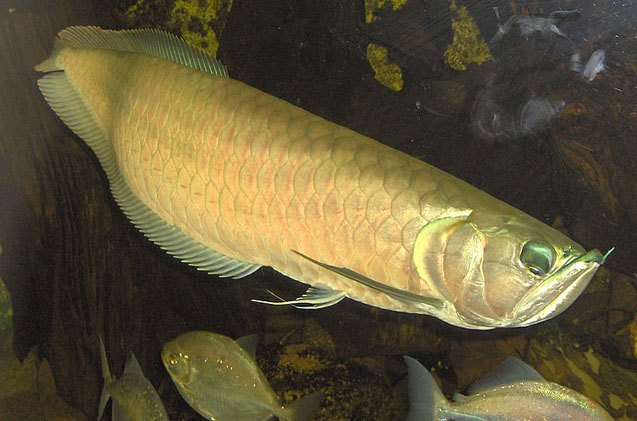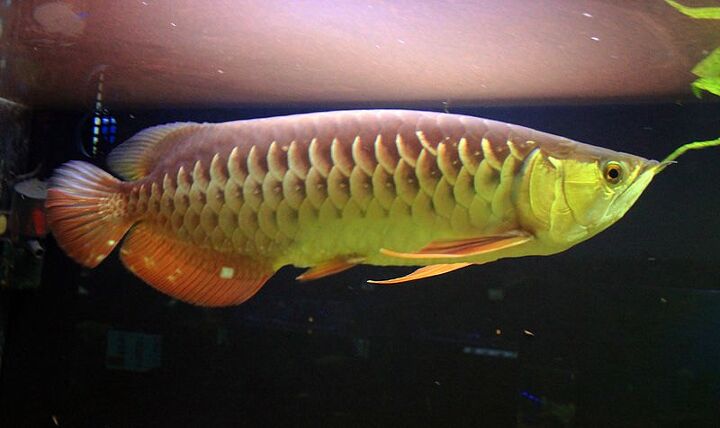
Arowana General description
Sometimes referred to as the dragon fish, Arowanas are one of the most beautiful and most fascinating species of fish in the aquarium trade. They are considered a Jurassic era species and have been around for over a 100 million years. The Arowana has a bony head and a long, powerful body. Their bodies are also covered in large, heavy scales with a mosaic pattern of canals. They are sometimes referred to as “bonytounges” because of the toothed bone at the bottom of their mouth which bites against the roof of their mouth. Arowana are also characterized by two, darkly colored, barbells that extend from its bottom lips. These barbells are often delicate, and can easily be damaged by rough handling.
Due to their demanding nature and sheer size, the task of raising this fish should only be attempted by dedicated and experienced aquarist. They are also one of the most expensive species of aquarium fish, with some adult specimens commanding tens of thousands of dollars. In fact, a platinum arowana keeps the record as the most expensive aquarium fish ever sold when its price tag reached a whopping $400,000. The high value of these fish makes them very coveted among aquarists, but they’re not easy to come across. Arowanas are microchipped before they reach maturity to ensure the buyer knows that they were bred in captivity. In the wild, arowanas are considered endangered so the aquarium species all come from Asian arowana farms.
Sometimes referred to as the dragon fish, arowanas are one of the most beautiful and most fascinating species of fish in the aquarium trade.
Origins
Arowanas are ancient fish with millions of years of history. Currently, there are about 10 arowana species that are kept as aquarium fish, and they originated either in South America, Australia, Asia, or Africa. In fact, they are the only freshwater species that can be originally found both in the waters of Asia and Australia.
The most exotic and colorful species is from southeast Asia, the aptly named Asian Arowana or dragonfish. The silver arowana comes from South America, and it is native to the Amazon, Essequibo and Oyapock basins. This type of arowana is the least expensive one, as they are least restricted to import and export. Black arowana is also a South American species. Lastly, there are the rare Australian arowanas, also known as southern or gulf saratoga. They are native to the Fitzroy river system and the Gulf of Carpentaria drainage system. Australian arowanas are not considered endangered.
Color
The sleek, metallic scales of arowanas are one of the things aquarists most like about them. There are at least ten different aquarium arowana species, and the color of their scales will largely depend on the species they belong to. For instance, the Asian arowanas are, without a doubt, the most vivid and vibrant of the family. Some of the colors of these fishes are green, blue and gold, silver, and the popular blood red. The colors start out a bit duller in their juvenile years and intensify and transform when the fish matures.
Their cousins, silver and black arowanas from South American waters keep their hues throughout their life. The Australian arowanas are mostly dull in coloring, leaning towards darkish grey and brown tones, although they can sometimes have spotted scales.
Maintenance and care

Arowana are one of the largest growing species of aquarium fish and can sometimes reach lengths of over 4 feet. For this reason it is recommended that they are raised in extremely large tanks of over 250 gallons or large outdoor ponds. Arowanas prefer aquariums with both large open swimming spaces and sufficient hiding spots. They mostly swim near the surface region of the aquarium and are incredibly powerful jumpers. Arowanas in the wild have been spotted jumping 10 feet or more to capture insects and birds. For this reason it is crucial that the arowana’s aquarium be tightly covered with a heavy lid.
Arowana are extremely heavy eaters and tend to produce a lot of waste. Therefore it is crucial that aquarists pay careful attention to their water conditions and not let the ammonia, nitrite and nitrate content of the arowana aquarium reach hazardous levels. Water changes of up to 20% are recommended twice a week. Additionally, their tank will require a powerful filtration system. Most arowana owners that keep these fishes in a tank decide on getting a sump filter, or a powerful, high-end canister filter.
A well cared for arowana will often live for up to 15 to 20 years. This is one of the reasons why these fishes are a bad choice for inexperienced aquarists- they require a lot of care and commitment and often for two decades. Keeping arowanas is a serious commitment, both financial and effort-wise, as these striking specimens will need a lot of space and care to thrive in a home setup.
However, even though their size dictates special care requirements, when it comes to the water itself, they are not overly finicky. Most arowanas can adapt to a variety of conditions, but making sure that the water pH value and temperature are close to their preferred values will only increase their longevity and quality of life. These imposing fishes do best in well filtered, soft, and slightly acidic freshwater. The pH value of 6.4 to 6.8 is ideal for them. As for the temperature, they are usually happy when it’s around 28 degrees Celsius in the tank.
While younger arowana prefer to be kept in fairly large groups of 6 or more, they can turn extremely territorial and aggressive towards one other when reaching maturity. For this reason most arowana keepers prefer to keep arowanas alone. However, adult arowanas can be kept in large groups of 6 or more when raised in a large aquarium or pond with sufficient room.
Arowanas are extremely predatory and should not be kept with smaller sized fish. They can be kept in community tanks with large, non-aggressive species like knifefish, pacus, oscars, plecostomus, jaguar cichlids, green terrors, gars, tinfoil barbs, siamese tiger fish and other large species of catfish.
Feeding
Feeding arowanas can sometimes be a challenge because some adults only accept live foods. Arowanas are carnivores and have strong predatory instincts. They can be fed on a diet of feeder goldfish, frogs and shrimp.
Arowana are one of the largest growing species of aquarium fish and can sometimes reach lengths of over 4 feet.
Breeding
Breeding arowanas in an aquarium is virtually impossible and most arowana are bred in large fish farms in Asia. Arowana are mouth brooders and the males of the species carry the eggs in their mouths until the fry are hatched and their yolk sacks are fully absorbed. Arowana eggs are bright orange in color and the fry look like tiny marbles during the first few weeks of their lives. In most breeding farms, breeders “harvest” arowana fry by capturing the brooding males and forcing their mouths open, causing them to drop their broods of eggs or fry.
Aquarium varieties
Red, Golden, Silver, Jardini, Spotted, etc.
Photo credit: Qwertzy2/Wikimedia; Karelj/Wikimedia















